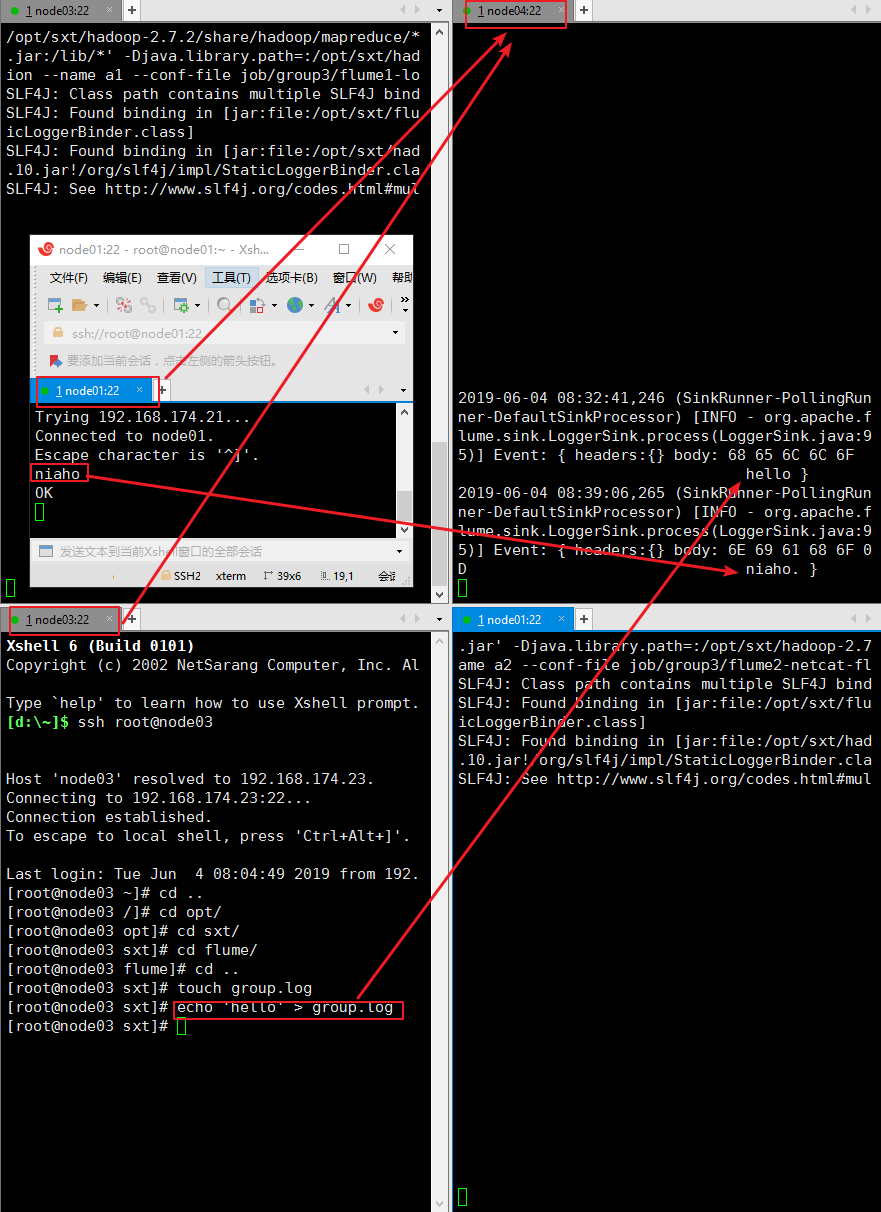第 3 章 企业开发案例
注释:一下hadoop102、hadoop103、hadoop104 分别由 node01、node03、node04 代替
3.1 监控端口数据官方案例
1)案例需求:首先,Flume 监控本机 44444 端口,然后通过 telnet 工具向本机 44444 端口发
送消息,最后 Flume 将监听的数据实时显示在控制台。
2)需求分析:
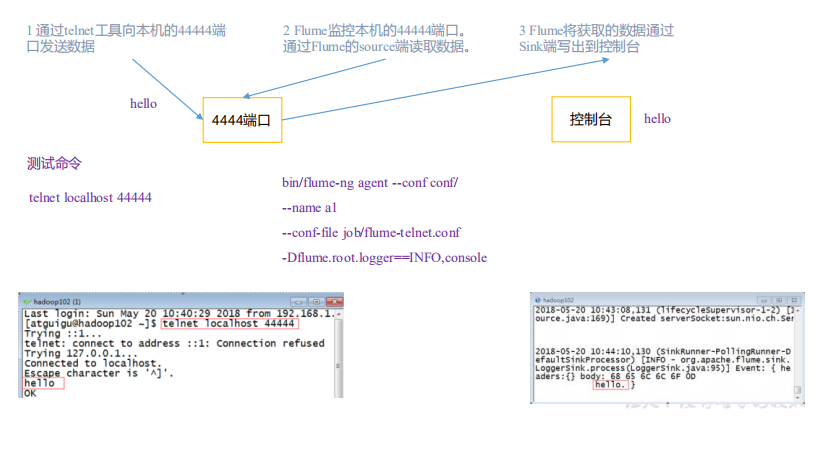
3)实现步骤:
1.安装 telnet 工具
将 rpm 软 件 包 (xinetd-2.3.14-40.el6.x86_64.rpm 、 telnet-0.17-48.el6.x86_64.rpm 和
telnet-server-0.17-48.el6.x86_64.rpm)拷入/opt/software 文件夹下面。执行 RPM 软件包安装命
令:
[atguigu@hadoop102 software]$ sudo rpm -ivh xinetd-2.3.14-40.el6.x86_64.rpm
[atguigu@hadoop102 software]$ sudo rpm -ivh telnet-0.17-48.el6.x86_64.rpm
[atguigu@hadoop102 software]$ sudo rpm -ivh telnet-server-0.17-48.el6.x86_64.rpm
或者:
1在线安装
分别执行如下两个命令:
yum install telnet
yum install telnet-server
2.判断 44444 端口是否被占用
[atguigu@hadoop102 flume-telnet]$ sudo netstat -tunlp | grep 44444
功能描述:netstat 命令是一个监控 TCP/IP 网络的非常有用的工具,它可以显示路由表、
实际的网络连接以及每一个网络接口设备的状态信息。
基本语法:netstat [选项]
选项参数:
-t 或--tcp:显示 TCP 传输协议的连线状况;
-u 或--udp:显示 UDP 传输协议的连线状况;
-n 或--numeric:直接使用 ip 地址,而不通过域名服务器;
-l 或--listening:显示监控中的服务器的 Socket;
-p 或--programs:显示正在使用 Socket 的程序识别码和程序名称;

3.创建 Flume Agent 配置文件 flume-telnet-logger.conf
在 flume 目录下创建 job 文件夹并进入 job 文件夹。
[atguigu@hadoop102 flume]$ mkdir job
[atguigu@hadoop102 flume]$ cd job/
在 job 文件夹下创建 Flume Agent 配置文件 flume-telnet-logger.conf。
[atguigu@hadoop102 job]$ touch flume-telnet-logger.conf
在 flume-telnet-logger.conf 文件中添加如下内容。
[atguigu@hadoop102 job]$ vim flume-telnet-logger.conf
添加内容如下:
# Name the components on this agent a1.sources = r1 a1.sinks = k1 a1.channels = c1
# Describe/configure the source a1.sources.r1.type = netcat a1.sources.r1.bind = localhost a1.sources.r1.port = 44444
# Describe the sink a1.sinks.k1.type = logger
# Use a channel which buffers events in memory a1.channels.c1.type = memory a1.channels.c1.capacity = 1000 a1.channels.c1.transactionCapacity = 100
# Bind the source and sink to the channel a1.sources.r1.channels = c1 a1.sinks.k1.channel = c1
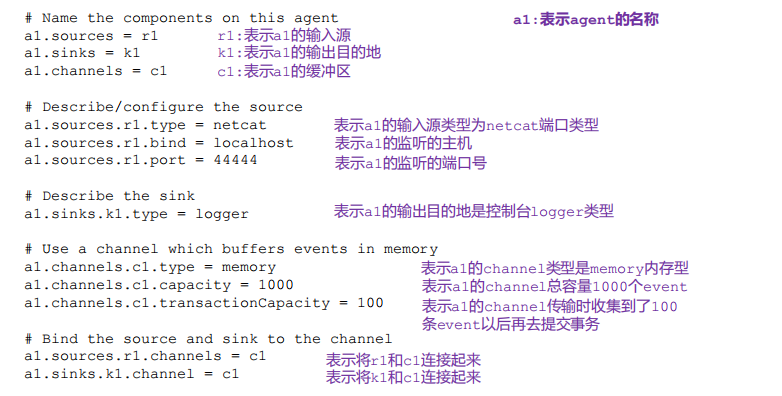
注:配置文件来源于官方手册:
http://flume.apache.org/FlumeUserGuide.html
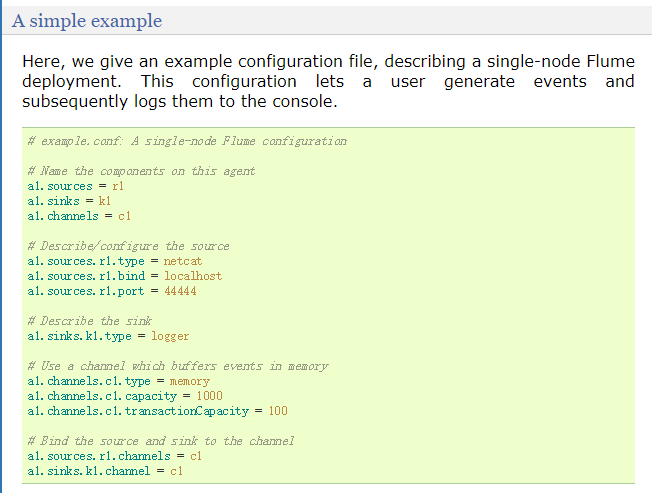
4. 先开启 flume 监听端口
[atguigu@hadoop102 flume]$ bin/flume-ng agent --conf conf/ --name a1 --conf-file job/flume-telnet-logger.conf -Dflume.root.logger=INFO,console
参数说明:
--conf conf/ :表示配置文件存储在 conf/目录
--name a1 :表示给 agent 起名为 a1
--conf-file job/flume-telnet.conf :flume 本次启动读取的配置文件是在 job 文件夹下
的 flume-telnet.conf 文件。
-Dflume.root.logger==INFO,console : -D 表 示 flume 运 行 时 动 态 修 改
flume.root.logger 参数属性值,并将控制台日志打印级别设置为 INFO 级别。日志级别包括:log、
info、warn、error。
5.使用 telnet 工具向本机的 44444 端口发送内容
[atguigu@hadoop102 ~]$ telnet localhost 44444
6.在 Flume 监听页面观察接收数据情况
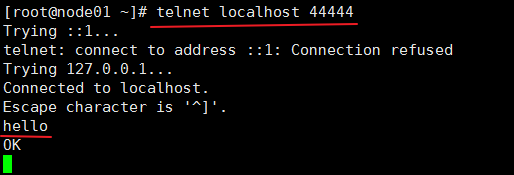

3.2 实时读取本地文件到 HDFS 案例
1)案例需求:实时监控 Hive 日志,并上传到 HDFS 中
2)需求分析:
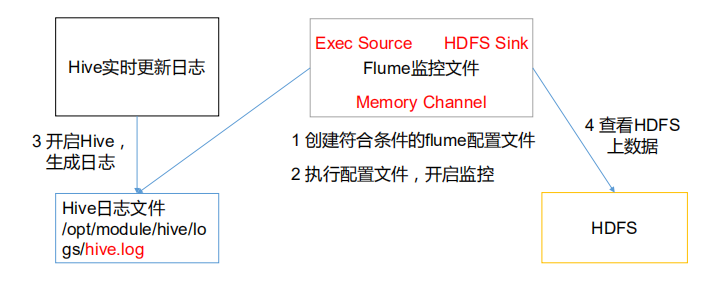
3)实现步骤:
1.Flume 要想将数据输出到 HDFS,必须持有 Hadoop 相关 jar 包
将
ommons-configuration-1.6.jar、
hadoop-auth-2.7.2.jar、
hadoop-common-2.7.2.jar、
hadoop-hdfs-2.7.2.jar、
commons-io-2.4.jar、
htrace-core-3.1.0-incubating.jar
拷贝到/opt/module/flume/lib 文件夹下。
2.创建 flume-file-hdfs.conf 文件
创建文件
[atguigu@hadoop102 job]$ touch flume-file-hdfs.conf
注:要想读取 Linux 系统中的文件,就得按照 Linux 命令的规则执行命令。由于 Hive
日志在 Linux 系统中所以读取文件的类型选择:exec 即 execute 执行的意思。表示执行 Linux
命令来读取文件。
[atguigu@hadoop102 job]$ vi flume-file-hdfs.conf
添加如下内容
# Name the components on this agent a2.sources = r2 a2.sinks = k2 a2.channels = c2 # Describe/configure the source a2.sources.r2.type = exec a2.sources.r2.command = tail -F /opt/sxt/hive/logs/hive.log a2.sources.r2.shell = /bin/bash -c # Describe the sink a2.sinks.k2.type = hdfs a2.sinks.k2.hdfs.path = /flume/%Y%m%d/%H #上传文件的前缀 a2.sinks.k2.hdfs.filePrefix = logs- #是否按照时间滚动文件夹 a2.sinks.k2.hdfs.round = true #多少时间单位创建一个新的文件夹 a2.sinks.k2.hdfs.roundValue = 1 #重新定义时间单位 a2.sinks.k2.hdfs.roundUnit = hour #是否使用本地时间戳 a2.sinks.k2.hdfs.useLocalTimeStamp = true #积攒多少个 Event 才 flush 到 HDFS 一次 a2.sinks.k2.hdfs.batchSize = 1000 #设置文件类型,可支持压缩 a2.sinks.k2.hdfs.fileType = DataStream #多久生成一个新的文件 a2.sinks.k2.hdfs.rollInterval = 600 #设置每个文件的滚动大小 a2.sinks.k2.hdfs.rollSize = 134217700 #文件的滚动与 Event 数量无关 a2.sinks.k2.hdfs.rollCount = 0 #最小冗余数 a2.sinks.k2.hdfs.minBlockReplicas = 1 # Use a channel which buffers events in memory a2.channels.c2.type = memory a2.channels.c2.capacity = 1000 a2.channels.c2.transactionCapacity = 100 # Bind the source and sink to the channel a2.sources.r2.channels = c2 a2.sinks.k2.channel = c2
配置分析:
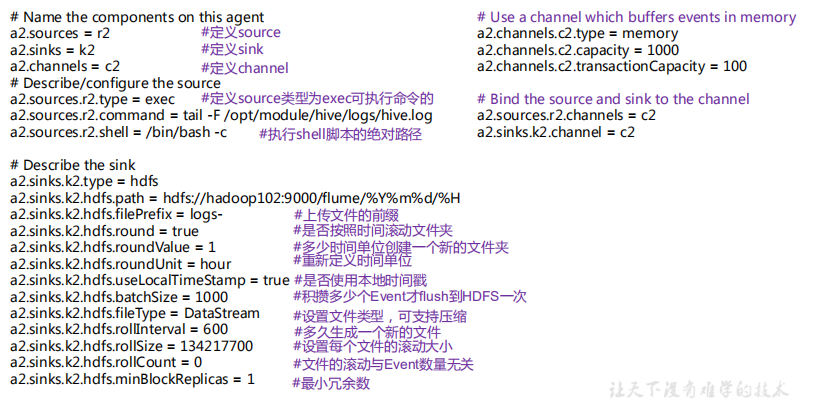
3.执行监控配置
[atguigu@hadoop102 flume]$ bin/flume-ng agent --conf conf/ --name a2 --conf-file job/flume-file-hdfs.conf
4.开启 Hadoop 和 Hive 并操作 Hive 产生日志
[atguigu@hadoop102 hadoop-2.7.2]$ sbin/start-dfs.sh
[atguigu@hadoop103 hadoop-2.7.2]$ sbin/start-yarn.sh
[atguigu@hadoop102 hive]$ bin/hive
hive (default)>
5.在 HDFS 上查看文件。
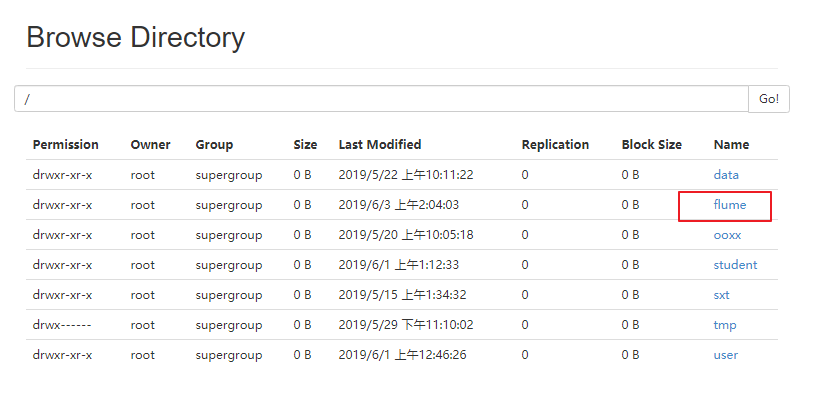
3.3 实时读取目录文件到 HDFS 案例
1)案例需求:使用 Flume 监听整个目录的文件
2)需求分析:

3)实现步骤:
1.创建配置文件 flume-dir-hdfs.conf
创建一个文件
[atguigu@hadoop102 job]$ touch flume-dir-hdfs.conf
打开文件
[atguigu@hadoop102 job]$ vim flume-dir-hdfs.conf
添加如下内容
# name
a3.sources = r3 a3.sinks = k3 a3.channels = c3
# Describe/configure the source a3.sources.r3.type = spooldir a3.sources.r3.spoolDir = /opt/sxt/flume/upload a3.sources.r3.fileSuffix = .COMPLETED a3.sources.r3.fileHeader = true #忽略所有以.tmp 结尾的文件,不上传 a3.sources.r3.ignorePattern = ([^ ]*.tmp)
# Describe the sink a3.sinks.k3.type = hdfs a3.sinks.k3.hdfs.path =/flume/upload/%Y%m%d/%H #上传文件的前缀 a3.sinks.k3.hdfs.filePrefix = upload- #是否按照时间滚动文件夹 a3.sinks.k3.hdfs.round = true #多少时间单位创建一个新的文件夹 a3.sinks.k3.hdfs.roundValue = 1 #重新定义时间单位 a3.sinks.k3.hdfs.roundUnit = hour #是否使用本地时间戳 a3.sinks.k3.hdfs.useLocalTimeStamp = true #积攒多少个 Event 才 flush 到 HDFS 一次 a3.sinks.k3.hdfs.batchSize = 100 #设置文件类型,可支持压缩 a3.sinks.k3.hdfs.fileType = DataStream #多久生成一个新的文件 a3.sinks.k3.hdfs.rollInterval = 600 #设置每个文件的滚动大小大概是 128M a3.sinks.k3.hdfs.rollSize = 134217700 #文件的滚动与 Event 数量无关 a3.sinks.k3.hdfs.rollCount = 0 #最小冗余数 a3.sinks.k3.hdfs.minBlockReplicas = 1 # Use a channel which buffers events in memory a3.channels.c3.type = memory a3.channels.c3.capacity = 1000 a3.channels.c3.transactionCapacity = 100 # Bind the source and sink to the channel a3.sources.r3.channels = c3 a3.sinks.k3.channel = c3
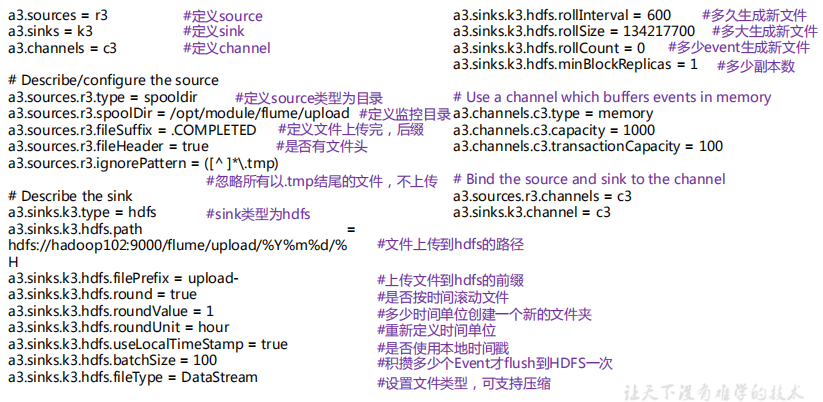
2. 启动监控文件夹命令
[atguigu@hadoop102 flume]$ bin/flume-ng agent --conf conf/ --name a3 --conf-file job/flume-dir-hdfs.conf
说明: 在使用 Spooling Directory Source 时
1) 不要在监控目录中创建并持续修改文件
2) 上传完成的文件会以.COMPLETED 结尾
3) 被监控文件夹每 500 毫秒扫描一次文件变动
3. 向 upload 文件夹中添加文件
在/opt/module/flume 目录下创建 upload 文件夹
[atguigu@hadoop102 flume]$ mkdir upload
向 upload 文件夹中添加文件
[atguigu@hadoop102 upload]$ touch atguigu.txt
[atguigu@hadoop102 upload]$ touch atguigu.tmp
[atguigu@hadoop102 upload]$ touch atguigu.log
4. 查看 HDFS 上的数据


3.4 单数据源多出口案例(选择器)
单 Source 多 Channel、Sink 如图 7-2 所示

图 7-2 单 Source 多 Channel、Sink
1)案例需求:使用 Flume-1 监控文件变动,Flume-1 将变动内容传递给 Flume-2,Flume-2
负责存储到 HDFS。同时 Flume-1 将变动内容传递给 Flume-3,Flume-3 负责输出到 Local
FileSystem。
2)需求分析:
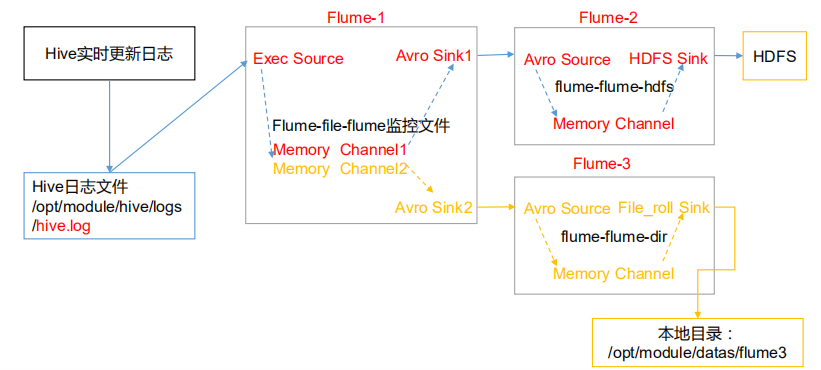
3)实现步骤:
0.准备工作
在/opt/module/flume/job 目录下创建 group1 文件夹
[atguigu@hadoop102 job]$ cd group1/
在/opt/module/datas/目录下创建 flume3 文件夹
[atguigu@hadoop102 datas]$ mkdir flume3
1.创建 flume-file-flume.conf
配置 1 个接收日志文件的 source 和两个 channel、两个 sink,分别输送给 flume-flume-hdfs
和 flume-flume-dir。
创建配置文件并打开
[atguigu@hadoop102 group1]$ touch flume-file-flume.conf
[atguigu@hadoop102 group1]$ vim flume-file-flume.conf
添加如下内容
# Name the components on this agent a1.sources = r1 a1.sinks = k1 k2 a1.channels = c1 c2
# 将数据流复制给所有 channel a1.sources.r1.selector.type = replicating
# Describe/configure the source a1.sources.r1.type = exec a1.sources.r1.command = tail -F /opt/sxt/hive/logs/hive.log a1.sources.r1.shell = /bin/bash -c
# Describe the sink a1.sinks.k1.type = avro a1.sinks.k1.hostname = node01 a1.sinks.k1.port = 4141 a1.sinks.k2.type = avro a1.sinks.k2.hostname = node01 a1.sinks.k2.port = 4142
# Describe the channel a1.channels.c1.type = memory a1.channels.c1.capacity = 1000 a1.channels.c1.transactionCapacity = 100 a1.channels.c2.type = memory a1.channels.c2.capacity = 1000 a1.channels.c2.transactionCapacity = 100
# Bind the source and sink to the channel a1.sources.r1.channels = c1 c2 a1.sinks.k1.channel = c1 a1.sinks.k2.channel = c2
注:Avro 是由 Hadoop 创始人 Doug Cutting 创建的一种语言无关的数据序列化和 RPC 框
架。
注:RPC(Remote Procedure Call)—远程过程调用,它是一种通过网络从远程计算机程
序上请求服务,而不需要了解底层网络技术的协议。
2.创建 flume-flume-hdfs.conf
配置上级 Flume 输出的 Source,输出是到 HDFS 的 Sink。
创建配置文件并打开
[atguigu@hadoop102 group1]$ touch flume-flume-hdfs.conf
[atguigu@hadoop102 group1]$ vim flume-flume-hdfs.conf
添加如下内容
# Name the components on this agent a2.sources = r1 a2.sinks = k1 a2.channels = c1
# Describe/configure the source a2.sources.r1.type = avro a2.sources.r1.bind = node01 a2.sources.r1.port = 4141
# Describe the sink a2.sinks.k1.type = hdfs a2.sinks.k1.hdfs.path = /flume2/%Y%m%d/%H
#上传文件的前缀 a2.sinks.k1.hdfs.filePrefix = flume2- #是否按照时间滚动文件夹 a2.sinks.k1.hdfs.round = true #多少时间单位创建一个新的文件夹 a2.sinks.k1.hdfs.roundValue = 1 #重新定义时间单位 a2.sinks.k1.hdfs.roundUnit = hour #是否使用本地时间戳 a2.sinks.k1.hdfs.useLocalTimeStamp = true #积攒多少个 Event 才 flush 到 HDFS 一次 a2.sinks.k1.hdfs.batchSize = 100 #设置文件类型,可支持压缩 a2.sinks.k1.hdfs.fileType = DataStream #多久生成一个新的文件 a2.sinks.k1.hdfs.rollInterval = 600 #设置每个文件的滚动大小大概是 128M a2.sinks.k1.hdfs.rollSize = 134217700 #文件的滚动与 Event 数量无关 a2.sinks.k1.hdfs.rollCount = 0 #最小冗余数 a2.sinks.k1.hdfs.minBlockReplicas = 1
# Describe the channel a2.channels.c1.type = memory a2.channels.c1.capacity = 1000 a2.channels.c1.transactionCapacity = 100
# Bind the source and sink to the channel a2.sources.r1.channels = c1 a2.sinks.k1.channel = c1
3.创建 flume-flume-dir.conf
配置上级 Flume 输出的 Source,输出是到本地目录的 Sink。
创建配置文件并打开
[atguigu@hadoop102 group1]$ touch flume-flume-dir.conf
[atguigu@hadoop102 group1]$ vim flume-flume-dir.conf
添加如下内容
# Name the components on this agent a3.sources = r1 a3.sinks = k1 a3.channels = c2
# Describe/configure the source a3.sources.r1.type = avro a3.sources.r1.bind = node01 a3.sources.r1.port = 4142
# Describe the sink a3.sinks.k1.type = file_roll a3.sinks.k1.sink.directory = /opt/sxt/datas/flume3
# Describe the channel a3.channels.c2.type = memory a3.channels.c2.capacity = 1000 a3.channels.c2.transactionCapacity = 100
# Bind the source and sink to the channel a3.sources.r1.channels = c2 a3.sinks.k1.channel = c2
提示:输出的本地目录必须是已经存在的目录,如果该目录不存在,并不会创建新的目录。
4.执行配置文件
分别开启对应配置文件:flume-flume-dir,flume-flume-hdfs,flume-file-flume。
[atguigu@hadoop102 flume]$ bin/flume-ng agent --conf conf/ --name a3 --conf-file job/group1/flume-flume-dir.conf
[atguigu@hadoop102 flume]$ bin/flume-ng agent --conf conf/ --name a2 --conf-file job/group1/flume-flume-hdfs.conf
[atguigu@hadoop102 flume]$ bin/flume-ng agent --conf conf/ --name a1 --conf-file job/group1/flume-file-flume.conf
5.启动 Hadoop 和 Hive
[atguigu@hadoop102 hadoop-2.7.2]$ sbin/start-dfs.sh
[atguigu@hadoop103 hadoop-2.7.2]$ sbin/start-yarn.sh
[atguigu@hadoop102 hive]$ bin/hive
hive (default)>
6.检查 HDFS 上数据

7 检查/opt/module/datas/flume3 目录中数据
[atguigu@hadoop102 flume3]$ ll
总用量 8
-rw-rw-r--. 1 atguigu atguigu 5942 5 月 22 00:09 1526918887550-3
3.5 单数据源多出口案例(Sink 组)
单 Source、Channel 多 Sink(负载均衡)如图 7-3 所示。

图 7-3 单 Source、Channel 多 Sink
1)案例需求:使用 Flume-1 监控文件变动,Flume-1 将变动内容传递给 Flume-2,Flume-2
负责存储到 HDFS。同时 Flume-1 将变动内容传递给 Flume-3,Flume-3 也负责存储到 HDFS
2)需求分析:
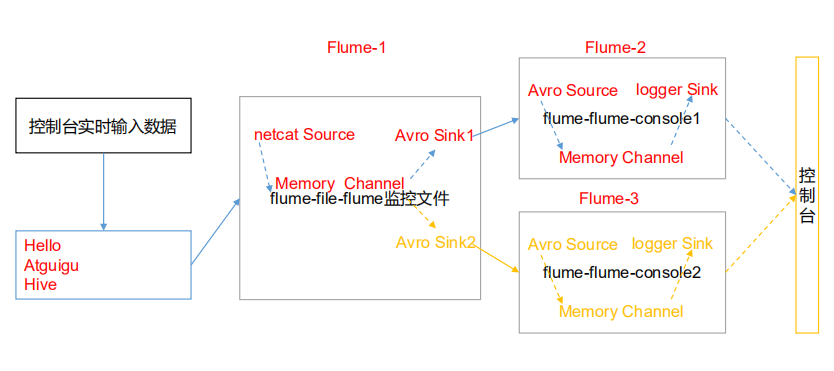
3)实现步骤:
0.准备工作
在/opt/module/flume/job 目录下创建 group2 文件夹
[atguigu@hadoop102 job]$ cd group2/
1.创建 flume-netcat-flume.conf
配 置 1 个接收 日 志 文 件 的 source 和 1 个 channel、 两 个 sink , 分 别 输 送 给
flume-flume-console1 和 flume-flume-console2。
创建配置文件并打开
[atguigu@hadoop102 group2]$ touch flume-netcat-flume.conf
[atguigu@hadoop102 group2]$ vim flume-netcat-flume.conf
添加如下内容
# Name the components on this agent a1.sources = r1 a1.channels = c1 a1.sinkgroups = g1 a1.sinks = k1 k2 # Describe/configure the source a1.sources.r1.type = netcat a1.sources.r1.bind = localhost a1.sources.r1.port = 44444 a1.sinkgroups.g1.processor.type = load_balance a1.sinkgroups.g1.processor.backoff = true a1.sinkgroups.g1.processor.selector = round_robin a1.sinkgroups.g1.processor.selector.maxTimeOut=10000 # Describe the sink a1.sinks.k1.type = avro a1.sinks.k1.hostname = node01 a1.sinks.k1.port = 4141 a1.sinks.k2.type = avro a1.sinks.k2.hostname = node01 a1.sinks.k2.port = 4142 # Describe the channel a1.channels.c1.type = memory a1.channels.c1.capacity = 1000 a1.channels.c1.transactionCapacity = 100 # Bind the source and sink to the channel a1.sources.r1.channels = c1 a1.sinkgroups.g1.sinks = k1 k2 a1.sinks.k1.channel = c1 a1.sinks.k2.channel = c1
注:Avro 是由 Hadoop 创始人 Doug Cutting 创建的一种语言无关的数据序列化和 RPC 框
架。
注:RPC(Remote Procedure Call)—远程过程调用,它是一种通过网络从远程计算机程
序上请求服务,而不需要了解底层网络技术的协议。
2.创建 flume-flume-console1.conf
配置上级 Flume 输出的 Source,输出是到本地控制台。
创建配置文件并打开
[atguigu@hadoop102 group2]$ touch flume-flume-console1.conf
[atguigu@hadoop102 group2]$ vim flume-flume-console1.conf
添加如下内容
# Name the components on this agent a2.sources = r1 a2.sinks = k1 a2.channels = c1 # Describe/configure the source a2.sources.r1.type = avro a2.sources.r1.bind = node01 a2.sources.r1.port = 4141 # Describe the sink a2.sinks.k1.type = logger # Describe the channel a2.channels.c1.type = memory a2.channels.c1.capacity = 1000 a2.channels.c1.transactionCapacity = 100 # Bind the source and sink to the channel a2.sources.r1.channels = c1 a2.sinks.k1.channel = c1
3.创建 flume-flume-console2.conf
配置上级 Flume 输出的 Source,输出是到本地控制台。
创建配置文件并打开
[atguigu@hadoop102 group2]$ touch flume-flume-console2.conf
[atguigu@hadoop102 group2]$ vim flume-flume-console2.conf
添加如下内容
# Name the components on this agent a3.sources = r1 a3.sinks = k1 a3.channels = c2 # Describe/configure the source a3.sources.r1.type = avro a3.sources.r1.bind = node01 a3.sources.r1.port = 4142 # Describe the sink a3.sinks.k1.type = logger # Describe the channel a3.channels.c2.type = memory a3.channels.c2.capacity = 1000 a3.channels.c2.transactionCapacity = 100 # Bind the source and sink to the channel a3.sources.r1.channels = c2 a3.sinks.k1.channel = c2
4.执行配置文件
分别开启对应配置文件:flume-flume-console2,flume-flume-console1,flume-netcat-flume。
[atguigu@hadoop102 flume]$ bin/flume-ng agent --conf conf/ --name
a3 --conf-file job/group2/flume-flume-console2.conf
-Dflume.root.logger=INFO,console
[atguigu@hadoop102 flume]$ bin/flume-ng agent --conf conf/ --name
a2 --conf-file job/group2/flume-flume-console1.conf
-Dflume.root.logger=INFO,console
[atguigu@hadoop102 flume]$ bin/flume-ng agent --conf conf/ --name
a1 --conf-file job/group2/flume-netcat-flume.conf
5. 使用 telnet 工具向本机的 44444 端口发送内容
$ telnet localhost 44444
6. 查看 Flume2 及 Flume3 的控制台打印日志
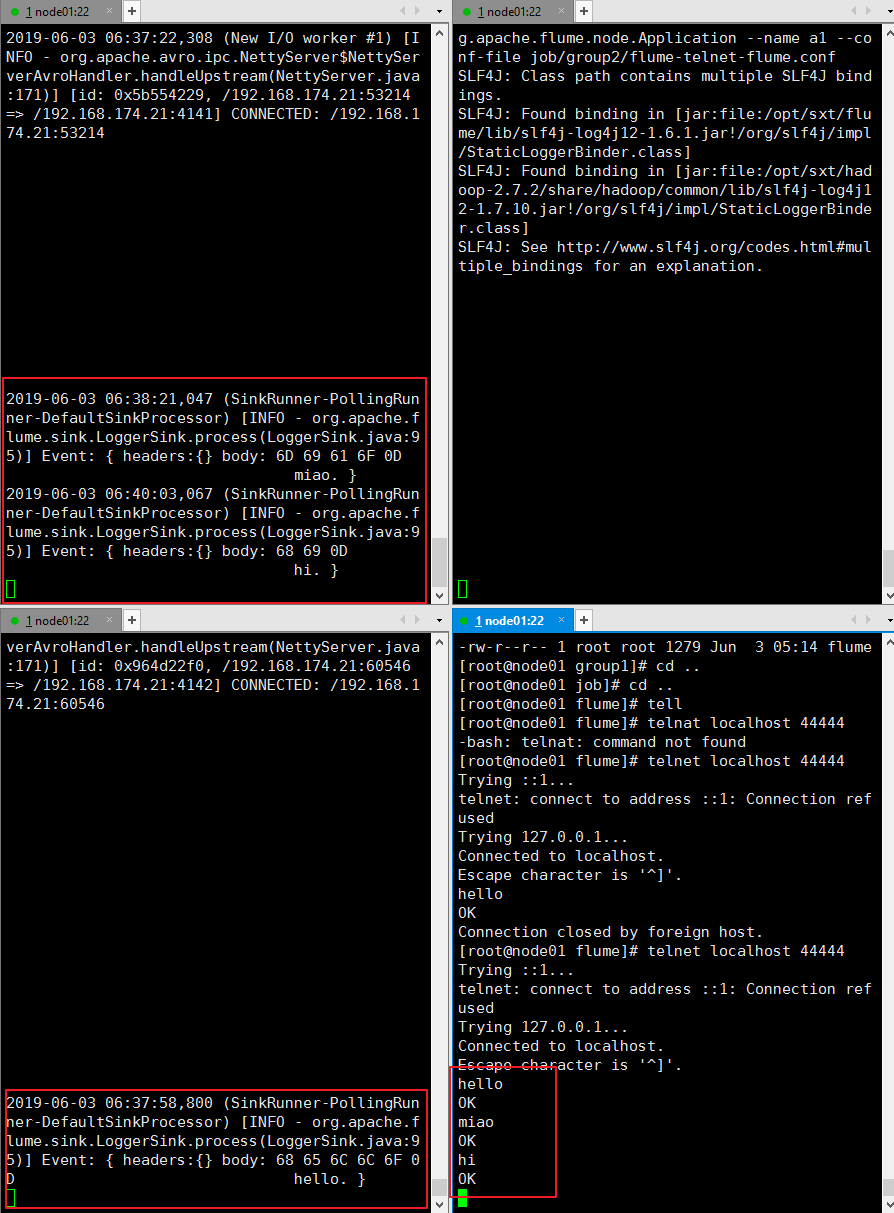
3.6 多数据源汇总案例
多 Source 汇总数据到单 Flume 如图 7-4 所示。
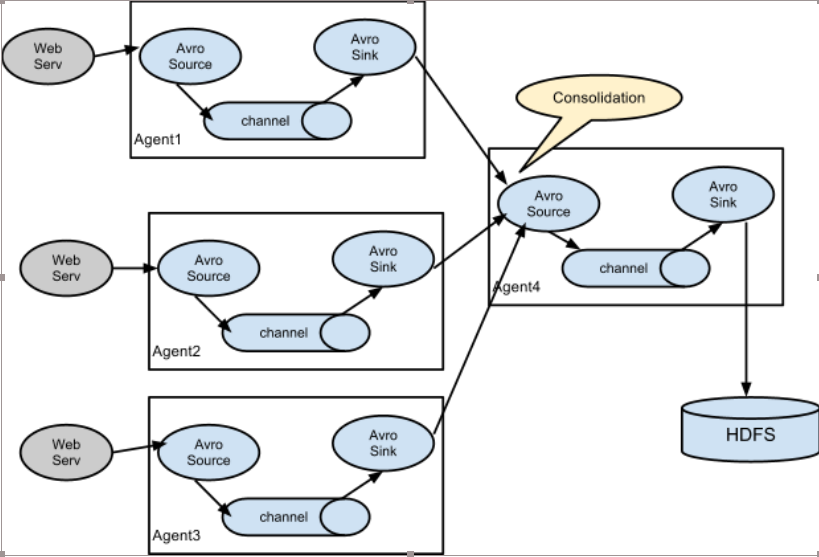
图 7-4 多 Flume 汇总数据到单 Flume
1) 案例需求:
hadoop103 上的 Flume-1 监控文件/opt/module/group.log,
hadoop102 上的 Flume-2 监控某一个端口的数据流,
Flume-1 与 Flume-2 将数据发送给 hadoop104 上的 Flume-3,Flume-3 将最终数据打印到
控制台。
2)需求分析:
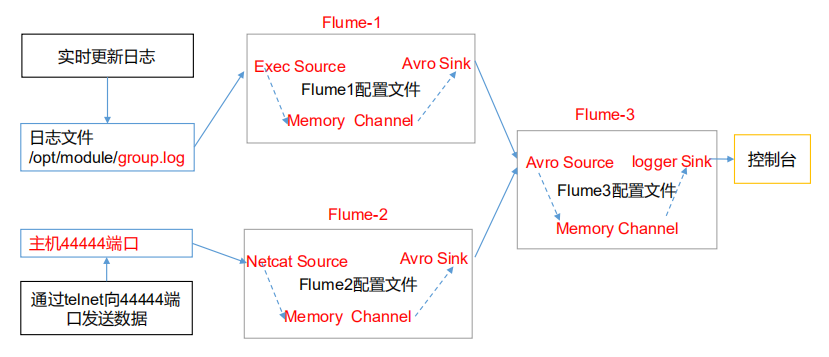
3)实现步骤:
0.准备工作
分发 Flume
[atguigu@hadoop102 module]$ xsync flume
在hadoop102、hadoop103以及hadoop104的/opt/module/flume/job目录下创建一个group3
文件夹。
[atguigu@hadoop102 job]$ mkdir group3
[atguigu@hadoop103 job]$ mkdir group3
[atguigu@hadoop104 job]$ mkdir group3
1.创建 flume1-logger-flume.conf
配置 Source 用于监控 hive.log 文件,配置 Sink 输出数据到下一级 Flume。
在 hadoop103 上创建配置文件并打开
[atguigu@hadoop103 group3]$ touch flume1-logger-flume.conf
[atguigu@hadoop103 group3]$ vim flume1-logger-flume.conf
添加如下内容
# Name the components on this agent a1.sources = r1 a1.sinks = k1 a1.channels = c1
# Describe/configure the source a1.sources.r1.type = exec a1.sources.r1.command = tail -F /opt/sxt/group.log a1.sources.r1.shell = /bin/bash -c
# Describe the sink a1.sinks.k1.type = avro a1.sinks.k1.hostname = node04 a1.sinks.k1.port = 4141
# Describe the channel a1.channels.c1.type = memory a1.channels.c1.capacity = 1000 a1.channels.c1.transactionCapacity = 100
# Bind the source and sink to the channel a1.sources.r1.channels = c1 a1.sinks.k1.channel = c1
2.创建 flume2-netcat-flume.conf
配置 Source 监控端口 44444 数据流,配置 Sink 数据到下一级 Flume:
在 hadoop102 上创建配置文件并打开
[atguigu@hadoop102 group3]$ touch flume2-netcat-flume.conf
[atguigu@hadoop102 group3]$ vim flume2-netcat-flume.conf
添加如下内容
# Name the components on this agent a2.sources = r1 a2.sinks = k1 a2.channels = c1 # Describe/configure the source a2.sources.r1.type = netcat a2.sources.r1.bind = node01 a2.sources.r1.port = 44444 # Describe the sink a2.sinks.k1.type = avro a2.sinks.k1.hostname = node04 a2.sinks.k1.port = 4141 # Use a channel which buffers events in memory a2.channels.c1.type = memory a2.channels.c1.capacity = 1000 a2.channels.c1.transactionCapacity = 100 # Bind the source and sink to the channel a2.sources.r1.channels = c1 a2.sinks.k1.channel = c1
3.创建 flume3-flume-logger.conf
配置 source 用于接收 flume1 与 flume2 发送过来的数据流,最终合并后 sink 到控制台。
在 hadoop104 上创建配置文件并打开
[atguigu@hadoop104 group3]$ touch flume3-flume-logger.conf
[atguigu@hadoop104 group3]$ vim flume3-flume-logger.conf
添加如下内容
# Name the components on this agent a3.sources = r1 a3.sinks = k1 a3.channels = c1
# Describe/configure the source a3.sources.r1.type = avro a3.sources.r1.bind = node04 a3.sources.r1.port = 4141 # Describe the sink # Describe the sink a3.sinks.k1.type = logger # Describe the channel a3.channels.c1.type = memory a3.channels.c1.capacity = 1000 a3.channels.c1.transactionCapacity = 100 # Bind the source and sink to the channel a3.sources.r1.channels = c1 a3.sinks.k1.channel = c1
4.执行配置文件
分 别 开 启 对 应 配 置 文 件 : flume3-flume-logger.conf , flume2-netcat-flume.conf ,
flume1-logger-flume.conf。
[atguigu@hadoop104 flume]$ bin/flume-ng agent --conf conf/ --name a3 --conf-file job/group3/flume3-flume-logger.conf -Dflume.root.logger=INFO,console
[atguigu@hadoop102 flume]$ bin/flume-ng agent --conf conf/ --name a2 --conf-file job/group3/flume2-netcat-flume.conf
[atguigu@hadoop103 flume]$ bin/flume-ng agent --conf conf/ --name a1 --conf-file job/group3/flume1-logger-flume.conf
5.在 hadoop103 上向/opt/module 目录下的 group.log 追加内容
[atguigu@hadoop103 module]$ echo 'hello' > group.log
6.在 hadoop102 上向 44444 端口发送数据
[atguigu@hadoop102 flume]$ telnet hadoop102 44444
7.检查 hadoop104 上数据
